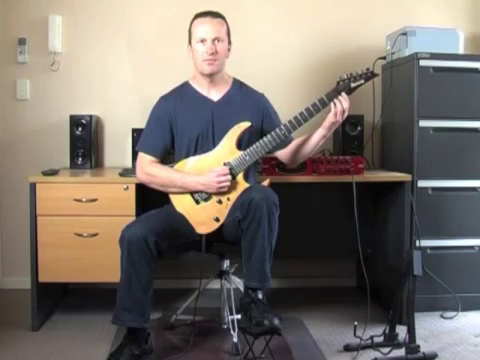Introduction
I must admit that when I first started playing guitar I didn’t pay any attention to my posture when I practiced guitar. I would just sit on the edge of my bed to practice, and often I would be slouched over for hours at a time learning from the guitar books and magazines that were strewn across the bed. Needless to say, this lack of attention to posture led me to get a sore neck and back on a fairly regular basis!
Now that I’m a lot older, and hopefully a little bit wiser, I pay a LOT more attention to my posture and how I hold my guitar while practicing. Although it might seem like a totally trivial detail, I feel that paying attention to how you hold your guitar is really important for a few main reasons…
- It can make a huge difference to how comfortable you are when you practice. And this can really affect how much enjoyment you get from practicing. It’s pretty hard to enjoy doing practice if you’re in physical discomfort as you do it!
- Sitting and holding your guitar in a way that is ergonomic can help prevent potential injuries, and can also help make sure that playing your guitar isn’t unnecessarily difficult.
- The way you hold your guitar can dramatically affect the transition between playing sitting down and playing standing up. Ideally, you want to practice sitting down in a way that transfers effortlessly to how your guitar is when you play standing up.
Let’s now take a look at the two main sitting positions that you can use when practicing your guitar…
The Casual Sitting Position
This is the most common way that you see electric guitarists holding their guitar when sitting down. I used the casual sitting position exclusively when I practiced for the first fifteen years of learning guitar. Here’s a photo of what it looks like…

The key things to notice from the picture above are…
- If you’re right-handed then your guitar will be resting on top of your right thigh with the back of the guitar resting against your torso.
- If you like to use a foot stool when practicing, then this be underneath the foot of the leg that your guitar is resting on.
- The neck of the guitar tends to angle away from the body quite a lot.
As I mentioned above, I used this method of holding the guitar for the first fifteen years of learning guitar. And while I still use the casual position if I’m jamming with other people or playing for fun, I don’t tend to use it for my actual guitar practice. There are a few reasons why I stopped using it for the majority of my guitar practice…
- It’s significantly harder to do wide-stretches using the casual sitting position. If you have average sized hands like me, then trying to do very wide stretches while using the casual sitting position tends to mean that you’ll have to contort your body in an awkward way.
- The guitar neck isn’t very stable. If you’re an advanced level player then this probably won’t affect you. But if you’re a beginner to intermediate level player then having an unstable guitar neck can make practicing the guitar harder than it needs to be.
- It doesn’t translate well to playing standing up. When you use the casual sitting position the guitar is in a very different position to when you are standing up. For some guitarists this can mean they can do a lot of practice sitting down, but when they play standing up things feel decidedly uncomfortable.
The Classical Sitting Position
This is the sitting position that I use for the majority of my practice. It took me a few months to get totally used to it, but I now find it to be the most comfortable sitting position by far. Here’s what it looks like…

As you might have noticed, it doesn’t look very cool. So you might not want to sit like this for gigs and other times people are watching you play. ? But it’s an extremely comfortable way to sit when you’re doing your guitar practice. The main things that you need to take away from the photo above are…
- If you’re right-handed then the guitar will be resting on your left thigh. The back of the guitar body will be resting against your abdominal area, and the inside of your right leg helps to stabilize the guitar.
- The guitar neck is angled upwards a lot more than when you’re using the casual sitting position.
- The guitar neck isn’t angled away from the body as much. This allows you to sit more upright, and maintain better posture, when you are practicing.
- Although it’s not obvious from the photo, the guitar neck is very stable when playing in the classical sitting position.
A Few Last Words
I really recommend giving the classical sitting position a go if you’ve never tried it before. Of course, if you decide to start using the classical sitting position, be sure to make the change by initially only doing short practice sessions in the new sitting position. As you start to get used to the new sitting position then you can gradually start to increase how much practice you do. This will help you to make the transition to the classical sitting position in a safe way.
Return To: Guitar Technique Lessons